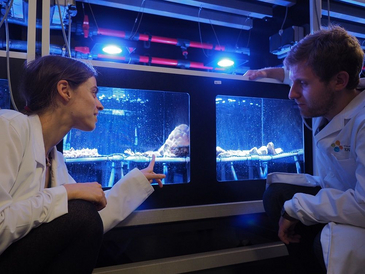Nitrogen fixing bacteria, common residents of tropical reef-building corals, contribute to coral bleaching even in the absence of ocean warming This is the key finding of a new study carried out by an international research team under the joint supervision of Prof. Dr. Christian Wild (Marine Ecology, University of Bremen, Germany) und Prof. Dr. Christian Voolstra (Reef Genomics, King Abdullah University of Science and Technology – KAUST – Saudi Arabien) at The Central Red Sea. The study was recently published in the prestigious international journal “Global Change Biology”. Dr. Claudia Pogoreutz and Nils Rädecker, who both graduated in the last 18 months from the University of Bremen and since then have been working as researchers at KAUST, are joint first authors of the study.
Coral bleaching and its linkage to ocean warming
So far, coral bleaching was mainly described in relation to ocean warming. Tropical reef-building corals are animals that thrive in seawater temperatures between ca. 23 ° and 30 °C. If the seawater temperatures exceed this comfort zone, coral bleaching can occur. In this process, corals appear white (‘bleached’). This is because healthy corals commonly harbor millions of microalgae that reside within the coral tissue. In the bleaching process, the microalgae leave their animal host. Bleaching is not necessarily deadly, but can significantly weaken the coral animal. The reason for this is that the microalgae provide the coral host with essential energy and nutrients. If the water temperatures drop back to normal levels in time, the coral can acquire new microalgae, and recover. If the high water temperatures however last for too long, bleaching can lead to a mass mortality of coralsd. In recent years, ocean warming in combination with El-Nino phenomena led to a high frequency of extended coral bleaching events with ensuing mass mortality. Indeed, three Global Bleaching Events occurred within the past three decades only: in 1998 in the Indian Ocean, in 2009/10 in the Central Pacific, and 2014-17 the longest bleaching ever recorded spanning reefs all around the globes.
The role of nutrients in coral bleaching
Recent studies however have shown that not only ocean warming, but also increased nutrient availability can cause coral bleaching. Particular forms of nitrogen, which damage critical compartments of the microalgae, can exacerbate the effects of ocean warming on coral health. Excess nitrogen can enter coral reefs via river discharge and terrestrial run-off. On the reef, however, ‘new’ nitrogen is also constantly created by a small group of microbes, the nitrogen fixing bacteria. This led Claudia Pogoreutz, Nils Rädecker, and their colleagues to investigate whether increases in bacterial nitrogen fixation can have a detrimental effect on coral health. By ‘feeding’ the coral-associated nitrogen fixers with sugar, the scientists were able to show that increased nitrogen fixation activity can indeed cause coral bleaching even in the absence of elevated sea temperatures.
The increased activity of nitrogen fixers apparently caused an imbalance in the coral: similar compared to the studies adding excess nitrogen to the seawater, increased nitrogen fixation in the coral disrupted the delicate symbiosis between the coral and the microalgae, causing coral bleaching.
These results now have several important implications:
On the one hand, this study provides a newly-discovered mechanism for coral bleaching. This finding now importantly supplements existing bleaching explanation approaches.
On the other hand, the study shows that the poorly understood contribution of nitrogen fixation in corals apparently is a central factor for the health of both of coral and microalgae. Changes in nitrogen fixation activity may therefore be fatal for corals.
Finally, the present study again emphasizes that coral bleaching is not only caused by the effects of global climate change, but can also be driven by local factors such as sugar input through sewage disposal from land. It is likely that a combination of global and local factors may be particularly severe for coral reefs.
Consequently, meaningful management actions for the conservation of coral reefs should include both the reduction of global and local factors. This is particularly important as the management of local factors is often more feasible, and can be more easily addressed in the near future.
Publication:
Pogoreutz, Rädecker et al. (2017) Sugar enrichment provides evidence for a role of nitrogen fixation in coral bleaching (Global Change Biology).
Weitere Informationen/Further information:
Prof. Dr. Christian Wild
University of Bremen
Faculty Biology / Chemistry
Marine Ecology
Phone. +49 421/218-63367
E-mail: christian.wildprotect me ?!uni-bremenprotect me ?!.de
Prof.Dr. Christian Voolstra, Dr. Claudia Pogoreutz, Nils Rädecker
Reef Genomics Group
Red Sea Research Center
King Abdullah University of Science and Technology (KAUST)
KAUST Building 2, Level 2
4700 Thuwal 23955-6900
Saudi Arabia
E-mail: christian.voolstraprotect me ?!kaust.eduprotect me ?!.sa, claudia.pogoreutzprotect me ?!kaust.eduprotect me ?!.sa, nils.radeckerprotect me ?!kaust.eduprotect me ?!.sa

